ISSN ONLINE(2319-8753)PRINT(2347-6710)
ISSN ONLINE(2319-8753)PRINT(2347-6710)
| T. Prihastuti Soil scientist, Indonesian Legume and Tuber Crops Research Institute, Malang, East Java, Indonesia |
| Related article at Pubmed, Scholar Google |
Visit for more related articles at International Journal of Innovative Research in Science, Engineering and Technology
The progress in agriculture technology have been able to develop worthwhile soil microbial to increase crop productivity and peaceful to environment. The purpose of this research is to study the effect of the use of bio fertilizers Illetrinut on peanuts variety Jerapah, and its interaction with the addition of manure to reduce the use of chemical fertilizers. Design of experiments carried out was factorial randomized block design, with the factor I was organic fertilizer comprised of (1) without any animal manure, and (2) given manure, and the factor II was awarding Illetrinut inoculant of, comprised of (1) without inoculant, given inorganic fertilizer P, K, (2) without inoculant, given inorganic fertilizer N, P and K, (3) inoculation Illetrinut A, and (4) inoculation Illetrinut B. The result shows that bio fertilizer Illetrinut may use on peanuts, which can provide quite good result be coupled with manure application by dosage 1.6 t/ha. On the application of bio fertilizer Illtrinut for the crops of peanut variety Jerapah are able to form pretty much root nodules (>100 nodules/plant), and produce the yield average 10.50-15.84 pods/plant and 41.00-64.33 seeds/plant.
Keywords |
| bio fertilizer of Illetrinut, peanut, effectivity, non-acid up land |
INTRODUCTION |
| Technology of bio-fertilizer in Indonesia was able to developed, that is driven by the desire to create a sustainable agriculture system. The basic principle is the utilization of bio-fertilizers with empower microbial activity for the support to plant growing, which is also expected to reducing of inorganic fertilizer applications, which further could well reducing the presence of chemistry residues in agricultural lands (Coleman and Whitman, 2005). The bio-fertilizer development after there was discovered the potential for soil microbes in the provision of plant nutrients, improving plant productivity and environmentally friendly (Walter dan Paau, 1993). |
| Besidesthe physicalcondition ofthe soil, the growthandproduction of peanutwas also determined byavailability of nutrients. The biological fertilizeris a materialcontaining thebeneficialmicrobesthatprovide nutrientstocropsrequired, especially N and P. Illetrinut is a biological fertilizer for the peanut, proceeds improvised by Indonesian Legume and Tuber Crops Research Institute. There are 2 types of bio-fertilizers Illetrinut, i e Illetrinut A and IlletrinutB, that was differentiated on the microbial composition. Like the other, Illetrinut invention needs to be examined their effectiveness on growth and yield of peanuts. |
| On the biological fertilizer application, the soil should be viewed as part living and interacting with the plants above it (Prihastuti, 2011). Soil has a particular biological structure, that directly affects the biogeochemical processes naturally (Aparicio and Costa, 2007). Some benefits of bio-fertilizer for plant growth, among others: (1) provides nutrients, especially N and P (Saraswatiet al., 2000 and Lal, 2002), (2) increase its resistance to pathogen attack (Linderman, 2004), (3) tolerant to heavy metals and toxic matter to plants (Setiadi, 2003), (4) improve the soil structure and does not contaminate the environment (Miller and Jastrow, 2004), and (5) one-time for plant fertilizer (Aher, 2004). |
| One of the objectives a biological fertilizer application is to improve of crop productivity in dry land, but it not yet all of them produce an outcome up to expectations. These circumstances was making the application of biological fertilizers become not so interesting, because the operational costs are not comparable to the increase in crop yields gained (Husenet al, 2007). |
| As a living material, the microbial must be adapt on the environments exist which supporting to their lived (Prihastuti, 2008). Despite the application of biological fertilizers is expected to be improving of the type and the amount of beneficial soil microbes, but it the success remain determined by the quality of biological fertilizers and the capabilities grown the microbes in of biological fertilizers on the new environmental conditions (PrihastutidanHarsono, 2012). Beside it, the study should be done to analyze of a biological fertilizers application regularly, with cropping pattern and seasons specifically on the same location and times (Sudaryonoet al., 2011). Accordingly the benefits of biological fertilizers to improving of the productivity of land and crops could be followed well over time. |
MATERIAL AND METHODS |
| This study was conducted at the greenhouse of Indonesian Legume and Tuber CropsResearch Institute, in October 2012-January 2013. Soil was used dry soil from the Experimental Station Kendal Payak, Malang District, East Java Province. Design of experiments carried out was factorial randomized block design with 6 replications (3 replications were harvested ripe for the physiologically and 3 replications for the root nodule observations were taken at the age of plants on 45 days after planting). The variety of Peanut was used Jerapah, with specifications according for the soil of non-acidic upland. Factor I was organic fertilizer comprised of (1) without any animal manure, and (2) given manure. Factor II was awarding Illetrinutinoculant of, comprised of (1) without inoculant, given inorganic fertilizer P, K, (2) without inoculant, given inorganic fertilizer N, P and K, (3) inoculation Illetrinut A, and (4) inoculation Illetrinut B. Analysis of the data using analysis of variance (ANOVA) and least significant difference test (LSD). The parameters measured were height of plant, seed yields, number of pods and weighting of 100 seeds. Chemical analysis was conducted on the soil pH, organic C, N, P, K, and CEC. Biological parameters measured were the number of root nodules and nodule dry weight. |
RESULTS AND DISCUSSION |
| Table 1 showed the results of the analysis a dry soil used in this study, indicating that the soil has N and P content is low enough for the plant life supporting over it, but has a high K womb relatively. Level of organic C content was also quite low, so indicating low organic matter content. The average the population of microbial in the soil was 36.3 x 103 cfu/g of soil, which most of the species of bacteria. Of a results chemical and biological soil analysis, showed that the soil used to this study fulfill requirements as peanut planting medium with an accompanied by biological fertilizer application and manure. That are used of manure comes from cattle manure that has been rotted in the cage. Results of chemical and biological analysis of animal manure showed that based on the number 28/Permentan/OT.140/2/2009 Agriculture Minister meets standards of quality organic fertilizer. The use of animal manure dosage was 1.6 tons/ha, equivalent 9 g/planting hole (Subandiet al., 2011). Considering themicrobial content, is expected touseanimal manureto enrich thesoilmicrobes, alsoincrease the number ofits population. Isro’i (2005) reported that the fertilesoil hasmicrobial content more than one hundred million per grams of soils. |
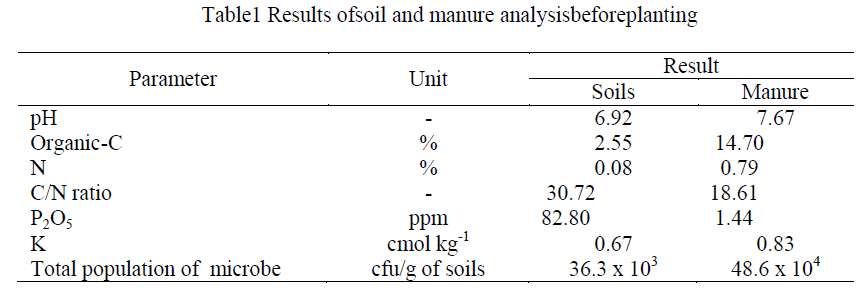 |
| Table 2 shows the quality of bio-fertilizers Illetrinut, has a near-neutral pH value and the value of C/N ratio of about 15. There are four (4) types of bacteria present in the composition Illetrinut in particular on the carrier material consisting of a mixture of Rawapening peat soil already wind dried and powdered charcoal with a ratio of 3:1 (Prihastuti, 2014). On the proportion ofthismaterialcontainsnutrients, especially PandKwith adignitythatwas good enough forplantgrowthmedia. In this carrier matter, Illetrinut was developed as a biological fertilizer that will benefit for peanut growth. Bio fertilizer of Illetrinut contains microbial approximately 108cfu/g of matter, has been meet the standard of biological fertilizer in Indonesia. |
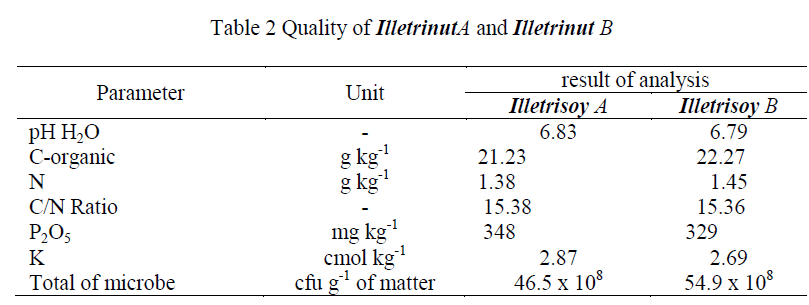 |
| Physically the variability of plant high on 45 days after planting showed the differences striking, with an average range of 17.75 to 20.92 cm (Table 3). This trend also occurred on the observation of dry weight and length of the roots of plants that were in a narrow range. There are many factors need to be put forward for explained this situation, so need to support other data showing the performance of the microbial activity on biological fertilizers. The effectiveness of bio fertilizer have influenced by microbial strains in it, growth environment and plant genotype (Ponmurugan and Gopi, 2006). These three factors are interrelated to one another and as the key to the successful introduction of bio fertilizer in the dry land. |
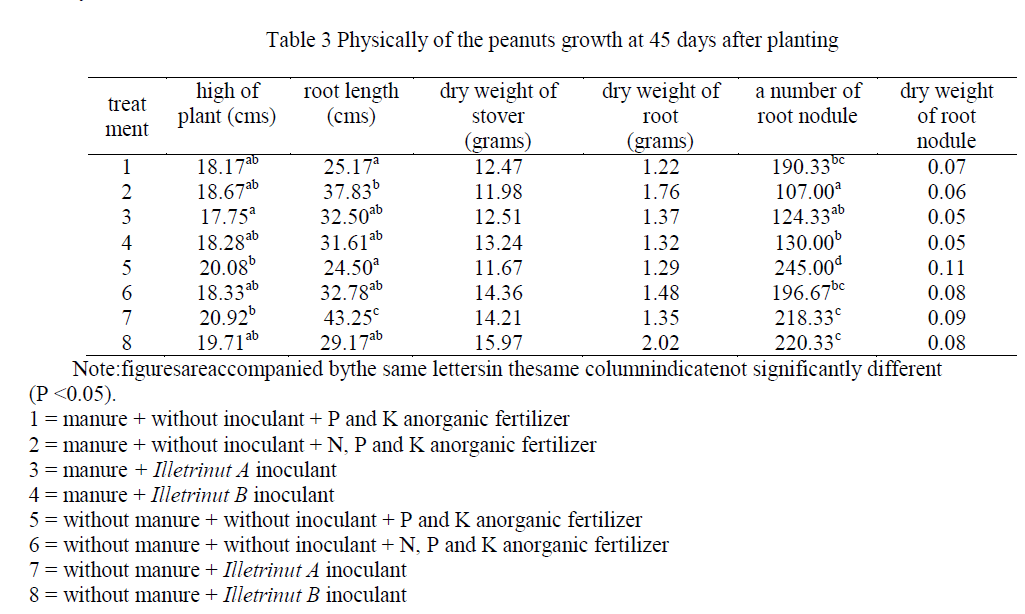 |
| The main components of bio-fertilizers Illetrinutare Rhizobium sp, so that the performance of the activities can be demonstrated by the presence of nodules (Harsonoet al, 2010). Root nodules formation is influenced by various factors including the content of lipo-polysaccharide, nutritional status and critical environmental factors (Denaire and Cullimore, 1993 inSudiana, et al., 2004). The effectiveness of Rhizobium in soils is determined by many factors such as soil pH, viability and competitiveness in the field of Rhizobium bacteria to parasites known as Rhizobiophage (Suharjo, 2001). |
| The bacteria were known as rhizobia rather unique among soil microbes, in the ability of peanuts symbiosis forming. To be in symbiosis, rhizobia not only to be able to live in a saprophyte, but also to be able to beat the other rhizobia in an attempt for the gain root infection (Jones, et al., 2007). Except for some strains, rhizobia can't fix N2 away from the peanuts host. However, if the observed number of root nodules growing on the root system reaches 107.00-245.00 nodules/plant, it can be indicated that there is a good interaction in the soil environment that supports the growth of root nodule-forming bacteria. Beside it anyway supported by the genetic properties Jerapah peanut variety is more susceptible to the establishment of a symbiotic relationship with the root nodule-forming microbes. |
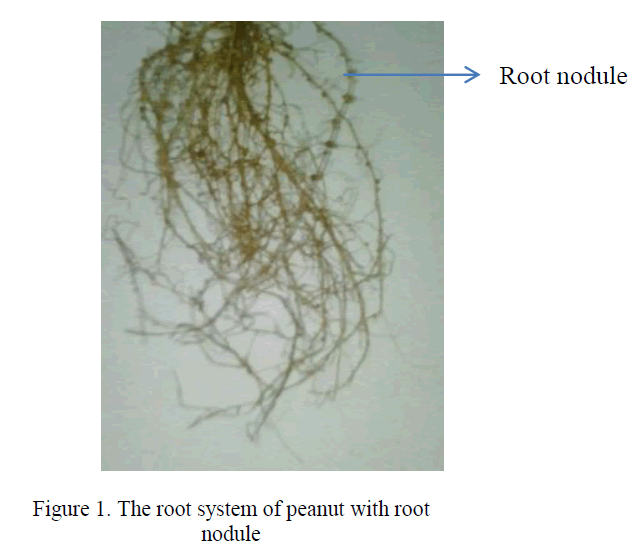 |
| A number of empty pods that form on all treatments are almost the same as range 4.83 to 6.83 pods/plant. Unlike the number of pods/plant showed a large range of 10.50 to 15.83 pods/plant. When considered in, then the formation of empty pods reached 38.98-60.63%, with an average 49.81%. Is this related to level of soil fertility? Is the use of manure and bio-fertilizers Illetrinut not been able to enrich the soil biological elements? Pasaribuet al. (1989) stated that the effectiveness of biological fertilizers influenced by microbial strains that exist in it, the growing environment and plant genotype. These three factors are interrelated to one another and as the key to the successful introduction of biological fertilizers. Biological fertilizer application is not as simple as using chemical fertilizers. Whatever type of microbes contained in the biological fertilizer, requires certain growing environment to grow and activity. Each land character has a chemical and physical composition, which will affect the responsiveness of the biological fertilizer and plants grown on the land. Similarly, plant genetic factors have a specific response against microbial activity that contained in biological fertilizers (Prihastuti, 2008). |
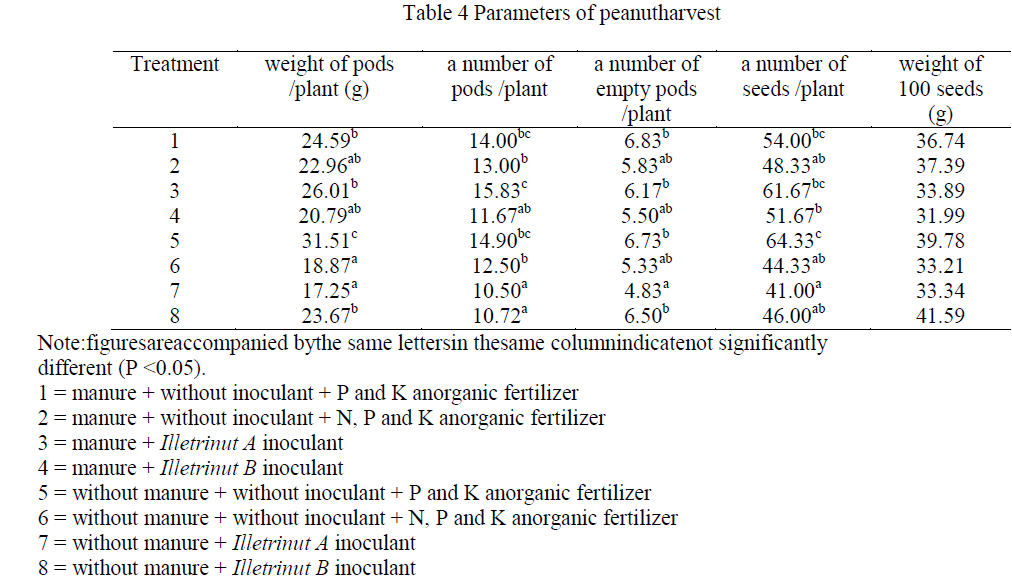 |
| The different treatment provides a different result in peanut yield, which indicate a meaningful interactions in manure application and inoculation of Illetrinut A the peanut seed yields (15.83 pods/plant and 61.67 seeds/plants). The use of bio-fertilizers Illetrinut produce seeds with higher numbers than without inoculation, especially had added with the use of manure. Apparently the positive response of Jerapah variety in root nodule formation is able to provide a better yield than the NPK fertilizer application (treatment 6). |
CONCLUSION |
| Bio fertilizer Illetrinut may use on peanuts, which can provide quite good result be coupled with manure application by dosage 1.6 t/ha. On the application of bio fertilizer Illetrinut for the crops of peanut variety Jerapah are able to form pretty much root nodules (> 100 nodules/plant). Performance of biological fertilizers Illetrinut for the peanut is better on the addition of animal manure. |
| In an effort to improve of the effectivity of the Illetrinut biological fertilizers, it is necessary to do several things, among others: (1) adjusting the environmental conditions of land into growing microbes contained in it, (2) improving the quality of biological components, including viability and microbial activity, and (3) the suitability responsive genotypes cultivated plants in a particular area. |
ACKNOLEDGMENT |
| We thank to Prof. Subandi and Prof. A. Harsonofor their kind technical support in executing this research. This research was funded by the government from the fiscal year 2012. |
References |
|